MAJOR RISKS ASSOCIATED WITH DAM CONSTRUCTION
A dam is a Civil Engineering construction which serves to contain the water of a natural course with two different aims, either alternative or simultaneous, according to the cases:
- To increase the level so that it can be diverted through a spillway in order to regulate the volume of water.
- To create a reservoir in order to retain the excess of water, allowing the supply of the liquid in moments of shortage.
Dams must fulfill a double function:
- they must be impervious and
- stable to resist the water pushing behind it.

Conde Guadalhorce Dam
Dam types
Dams can be grouped into two major categories on the basis of their composition:
- concrete dams and
- embankment dams.
The selection of one or the other type depends on the topography and conditions of the ground.

- Concrete dams are fundamentally constructed with concrete, with or without steel frameworks.
There are three different subcategories:
- Gravity dams: The water is held back because of the own weight of the dam, without the intervention of the arch shape.
Gravity dam scheme
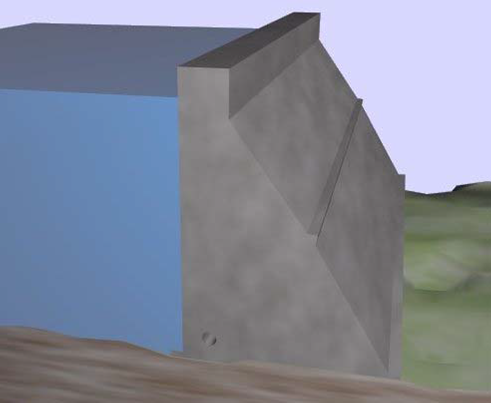
- Arch dams: Arch dams transmit the thrust (vertical and horizontal loads) towards its foundation and abutments, due to the “arch” effect. They may have horizontal or double -horizontal and vertical- curvature, which is the most normal.
Double curvature dam
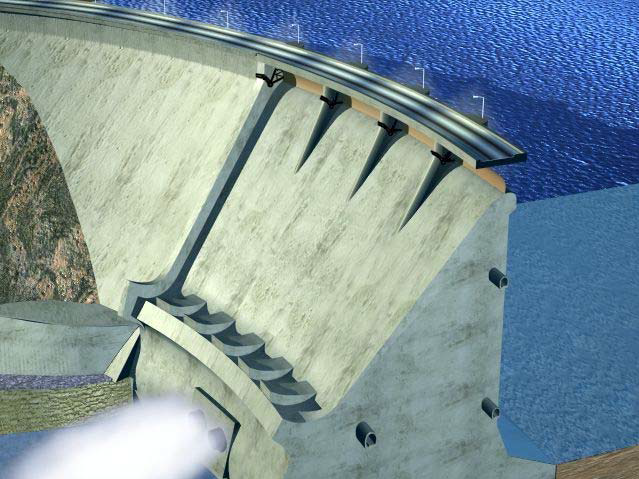
- Arch-Gravity dams: A combination of the two previous dam types. The single action of the curvature is insufficient to withstand the thrust and the dam must be provided with a certain weight to compensate this defect.
- Embankment dams are constituted by materials provided by nature which do not suffer any chemical process of transformation, being treated and laid through compaction procedures of soil mechanics, acting by gravity. They are composed of stone, gravel, earth, silt and clay, in accordance with the following classification:
- Rockfill dams. When more than 50% of the material is composed of rock.
- Earthfill dams. Also known as “rolled earth dams”. For materials with lower grain size.
According to the distribution of materials:
- Homogeneous: When all the material that the embankment dam is made of has the same characteristics. It may deal with more or less impervious materials (clay or silt). It requires very smooth slopes for the haunches to be stable under the different actions which may show up.
Homogeneous dam

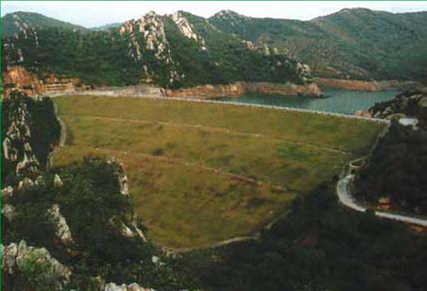
- Zoned: This is the most common type of dam, with employment of different materials, with an impervious core (usually clay) and more permeable materials as we get further from the dam core. So, one part of the dam fulfills the impermeability criterion and the rest has enough resistance to provide the construction with overall stability. They allow for higher slope inclination, so that the dam occupies a lower surface area.
Zoned dams may have two different construction typologies:
- An impervious core (made from clay or silt), either in the interior of the dam, in the centre (vertical or almost vertical) or near the upstream facing (inclined).
Heterogeneous embankment dam with central core

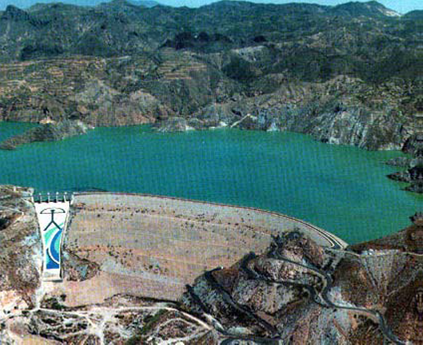
- An impervious facing covering the upstream slope area. This can be achieved through concrete or asphalt fabric screens.
Heterogeneous embankment dam with impervious screen


Construction method
Dam construction follows the following process:
- River diversion
For the construction of the dam side in the course of the river, it is necessary to divert the river to create a dry work area at the dam site.
This dry area can be created in two different ways:
- By totally diverting the river through an artificial course. It consists of the construction of an artificial course, for which it is needed to construct a temporary dam, called cofferdam (or diversion dam), in order to make a pool for the water to enter through the new course. It is a conduit (open channel or pipe) which transports the diverted water to a spot downstream. Moreover, the cofferdam shall contain the waters which cannot be held by the conduit.
Diversion tunnel at Ralco dam (Chile)

Stone cofferdam at Three Gorges Dam (China)
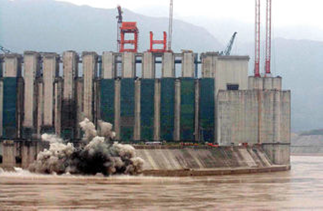
- By leaving only a portion of the waterway dry and channelling the passage of current through the rest, thus successively carrying out the work.
- Auxiliary works
It is necessary for dam construction to transport large amounts of construction material, in many cases across very irregular or mountainous land. Therefore, it becomes necessary to construct provisional access roads and bridges, as well as tunnels (in occasions) or even to carry out slope filling works, etc.
Moreover, depending on the function to be fulfilled by the dam, different water pathways must also be built -most of them underground- including the respective water inlet and outlet structures.
These works include:
- Water intake towers and supply tunnels for water supply projects.
- Upstream and downstream galleries.
- Surge shafts.
- Galleries for hydroelectric plant turbine room and transformers.

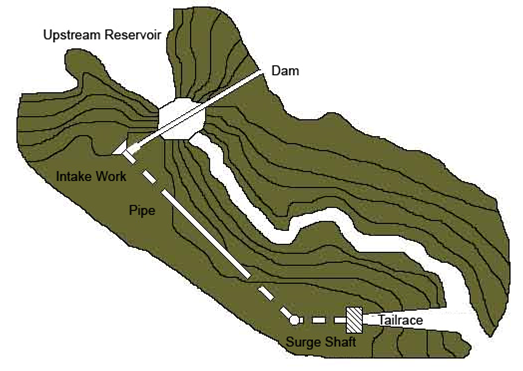
- Construction of the dam itself
The construction method varies depending on the type of dam:
- Concrete dams. These are built basically through two different methods:
- Conventional method. Individual sections are constructed as blocks and concreted forming “towers”, the size of which depends on considerations in relation to the construction project and the setting heat to be expected. In this case, the decisive factors are: the temperature during the on-site concrete casting, the cement percentage, the concrete cooling system and the weather conditions at the dam site, as the setting and cooling temperatures may be affected.
Construction with blocks

There must be interruptions during the construction, so that construction joints are produced, which are practically horizontal shaped. Besides, the so called functional joints are constructed in order to prevent cracks from occurring in the concrete expansion and contraction processes -with possible seepage and resistance reduction-, causing the division of the dam into blocks with certain independence from each other. After the project completion, when the dam’s own weight acts, and prior to filling the reservoir, cement suspension is injected in the block cracks in order to achieve the monolithic structure.
- RCC (Roller Compacted Concrete) Method. RCC is also known as “Rollcrete”. In this construction technique, the concrete is transported to the dam surface by trucks or conveyor belts. Then, it is distributed with bulldozers and compacted with vibratory rollers. The thickness of the concrete layer ranges between 30 and 50 cm. In order to ensure watertightness on both sides (dam facings), these are built of concrete according to the conventional method. Additionally, cement mortar is laid between the horizontal layers of Roller Compacted Concrete.
Concrete is saved by using this method, together with a lower setting heat, thus avoiding the functional joints. Therefore, it is more economical than the previous technique.
Ralco dam construction (Chile)
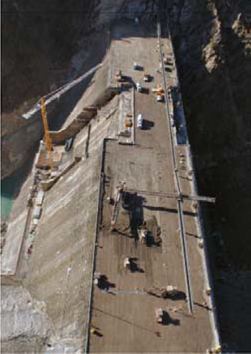
- Embankment dams:
- Impervious inner core. Embankment dams are built by placing selected layers (30 to 50 cm thick) of fill material with different grain size, pre-treated if necessary. This material is compacted, important operation to prevent settlements and obtain the maximum resistance. During compaction, as the optimum degree of density depends on the water content of the material, work must stop during rainfall. In isolate cases, hard rainfall may make necessary the removal of material already placed and compacted before placing the next layer.
- Rockfill dams with impervious face
- Concrete-faced rockfill dams (CFRD): The impervious element in this type of dam is a concrete slab on the upstream slope in contact with the reservoir water. The concrete face is made up by triangle-shaped or quadrilateral-shaped slabs joined by means of impervious joints (corrugated copper plates or some bituminous substance), and allowing the independent movement of each slab.
At the dam toe, on the upstream side, the slab is connected to a concrete retaining wall which forms the transition between the rock subsoil and the impervious concrete slab.
The fundamental defect of the concrete face is the great difference in deformability compared to the material of the dam, which makes it very sensitive to possible dam settlements, which may leave the wall unsupported, and therefore they are reinforced in two directions.
- Asphalt facing: The impervious element is a bituminous layer placed on the upstream slope of the dam.
The advantage lies in the fact that, besides being impervious, the material is also flexible, so that it adapts very well to dam settlements. Additionally, the construction and repair are easy and fast, and in the event of cracks occurring, they may close on their own thanks to the plasticity feature of the material.
Execution of asphalt layer at Ralco dam

The construction method is similar to concrete facing rockfill dams, with the difference that the asphalt layer is laid once the dam body has reached its definitive height. The face is generally built in several layers (30-50 cm thick), and it must be supported on a flat surface made of porous or asphaltic concrete. The tamping is done with rollers moved from the crest.
RISKS
- The project and construction of a dam present special problems demanding high knowledge of several sciences and techniques: Geology, foundations, Hydraulics, properties and treatment of materials, etc. Perhaps, that is the reason why it requires, more than any other construction project, the collaboration of several specialists and team work. As a conclusion, the plan and the project have special importance in dam construction, for the corresponding works and for the river diversion system.
- River diversion. The maximum flood to be diverted is the major problem in designing and determining the dimensions of the diversion elements. It must be determined based on the following dilemma:
- If we fall short, floods higher than the diversion capacity will be spilt over the diversion works and will flow through the old natural course, flooding the works that are being built.
- If, in order to avoid this, a very wide diversion is done, it may be excessively costly.
The drainage capacity of diversion tunnels is generally designed to have a 30 to 50-year return period flood event, in order to prevent flooding during the construction. Therefore, the two major risks associated with dam construction during the construction stage are: 1) The possible flooding of the works due to rain-induced floods (they are very sensitive to natural hazards), as such flows are not contained by the diversion elements; and 2) The risks derived from the necessary explosions to demolish the temporary cofferdams.
Two moments of a cofferdam demolition (with explosives) at Three Gorges Dam (China)
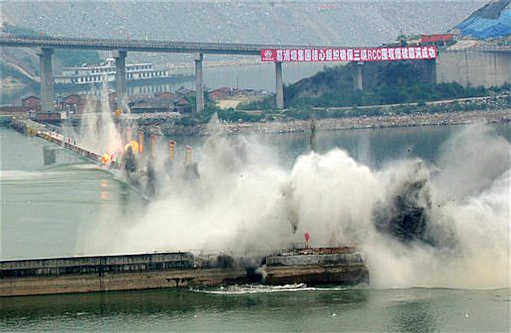

- Auxiliary works. Due to the fact that access roads are provisional, no coating layer is applied on them, meaning that they are exposed to rain and possible floods.
In general, temporary works (roads, bridges, fillings, etc.) are very affected by landslides induced, for example, by hard rainfall; as well as natural hazards (earthquakes, etc.).
- Materials storage warehouses and construction machinery are highly exposed to landslides, if they are located in the proximities of slopes susceptible to landsliding.
- Embankment dams. These dams do not withstand being overtaken by floods, both during construction and once under operation, as the little cohesion of the materials they are composed of could be reduced, which might cause the collapse of part of the wall, as well as filtration areas. That is why it is important to carry out a good study on historical rainfall on the river during the project stage.
The dam toe is one of the most important elements in the construction of concrete facing dams. Its correct formation is essential to assure the watertightness of the dam.
Internal erosion may develop in the joint zones between the impervious material of the dam core and the integrated concrete structures (bottom drain, etc.). In order to prevent this phenomenon, they must be planned and constructed with special care.
- Double curvature dams. They are very slender and may adopt very daring and complex shapes, which allows them to be very high and with small thickness. This complexity requires great skillfulness and experience from the constructors, who must resort to uncommon construction systems and the use of expensive construction equipment as well. Due to this, any mistake made either during the planning or the project stage may lead to future accidents.
Generally, because of the large loads transmitted to the ground due to the “arch” effect, it must be resorted to extensive foundation works.
Concrete may be altered by the presence of meteorological or environmental agents, by increasing its resistance in direct proportion to its thickness. Increase in thickness may lead to being less demanding with the quality of the materials in order to save costs.
- A double curvature dam must be monolithic, so that the dam site is required to be resistant and little deformable, resorting if necessary to ground improvement techniques (injections, etc.).
- Although damage by fire is not one of the major risks for these construction projects, material warehouses, workshops and construction equipment must be equipped with their corresponding fire extinguishing equipment.
As for the basin (bowl-shaped piece of land which serves for containing water) and the dam site (piece of land where the dam itself is located), they are required to be impervious, so that it is necessary to prevent seepage insofar as possible. Due to this, it is vital to conduct a proper ground study in order to get to know its characteristics and mechanical behavior. For example, limestone soil which may have caverns would be bad soil, whereas marl or granite grounds (provided they are not jointed) show a good behavior.
Profil Penulis:
https://www.cii.co.uk/membership/international/goodwill-ambassadors/russel-effandy-biography/
Pelatihan terkait risiko Konstruksi Bendungan:
Contact Us:
(Untuk info lebih detail & konsultasi gratis tentang Risk Engineering)
+628129992037 (Russel Effandy)
+6281293617419 (Cepa Jasa Indonesia Center – CJIC)

Facebook Comments





